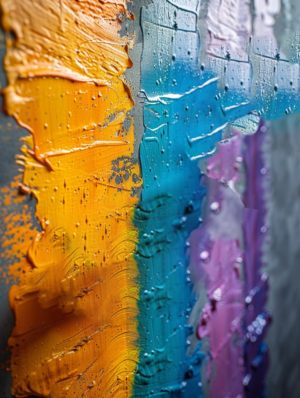 By brushing or spreading thick textured paint onto your walls, you can give your surface depth, interest and personal expression. You won’t have to be limited by landscape or topography, as you can turn your feature wall into any landscape you choose. For a more subtle treatment, you can enhance a space’s aura. But you can also succeed in creating bold statements. In this guide, we’ll show you how to get there and paint your thick textured paint artwork.
By brushing or spreading thick textured paint onto your walls, you can give your surface depth, interest and personal expression. You won’t have to be limited by landscape or topography, as you can turn your feature wall into any landscape you choose. For a more subtle treatment, you can enhance a space’s aura. But you can also succeed in creating bold statements. In this guide, we’ll show you how to get there and paint your thick textured paint artwork.
Understanding Thick Textured Paint
Thick textured paint, sometimes called textured or relief paint, contains an amount of spackle that makes it substantial enough to apply in a way that leaves an identifiable texture on the surface. Types of texture include sand, gypsum (plaster) or small stones mixed into the paint, which makes it more suitable for the application of raised patterns.
Preparing Your Space and Materials
Once finally committed to your abstract design, however, you take the first, dispiriting step, where it is all about preparation. What sort of textured paint should you use? Do you want the effects to be glossy? Or matt? And is the space functional: a bathroom or a kitchen? You might want something a little more robust.
- Materials Needed:
- Dry Wall Compound
- Latex based paint
- Primer (if necessary)
- Paint trays
- Trowels, brushes, or textured rollers
- Masking tape
- Drop cloths or plastic sheeting
- Preparation Steps:
- Clear the room or area you’ll be painting.
- Lay down drop cloths or plastic sheeting to protect your floors and furniture.
- When painting your wall, apply a primer if needed (following the manufacturer’s instructions) and allow it to dry thoroughly.
- Mix paint 2/3 paint to 1/3rd premixed compound.
• To create clean lines, towel off the wall and put masking tape down along edges that meet the ceiling, baseboards and adjacent walls.
Mixing the paint
Get dry wall compound and paint in a large large bucket. Make too much, not enough. Very hard to match it later.
Application Techniques
The way you spread the mixture will have a profound effect on how the texture will look. You can create different textures based loosely on the tool you use, like a brush, roller or a trowel.
- With a Trowel: For coarser textures, the trowel allows you to sculpt the paint, roughening it to make ridges or swirls, or other patterns, taking a bit more skill but can end up with some great one-of-a-kind finishes.
* Sponging or ragging: Painting an area with a sponge that is wrung out or a rag that has been dipped in paint allows for less defined, more variable textures that add depth without crowding the space.
– Using a Brush or Roller: Used for lighter textured applications. The easiest method to apply paint and get an even coverage. Textured painting rollers are available to achieve consistent patterns.
Tips for Success
- Wax on, wax off: practise your chosen painted technique on a piece of cardboard or scrap wood before doing any walls.
- • Work in Small Sections: Textured paint dries quickly, so it is a good idea to continuously work on small manageable sections. A wet edge helps to keep seams between sections from being visible.
- Textured paints: For greater interest, consider applying more than one layer of paint. Allow each layer to dry thoroughly before applying the next.
- Drying time alert: Thick textured paint often takes longer to dry than standard paint. Drying times and drying conditions can also vary: check the manufacturer’s instructions.
Cleanup and Maintenance
When you’re done, make sure you thoroughly wash off thick textured paint with soap and water. Seal and store any usable paint left in the bucket to use for touch-ups, or for another job if the kind you used is universal to all walls.
Textured walls can be a hassle to maintain because of their uneven and inconsistent surface. Dusting and a delicate clean with mild soap and warm water will keep them fresh and vibrant.
Conclusion
Painting with textured paint provides you with a host of artistic and decorative opportunities, but it also opens up a world of possibilities for visually stunning and tactile surfaces when used effectively. In many cases, the benefits and delight of having a room painted in this manner may ultimately hinge largely on the efforts you do to prepare yourself for the job properly. By being prepared, choosing your tools and techniques wisely, and by practicing your technique, you’ll quickly learn that painting with textured paint offers many pleasing and practical ways to help you make your home more inviting and personal.